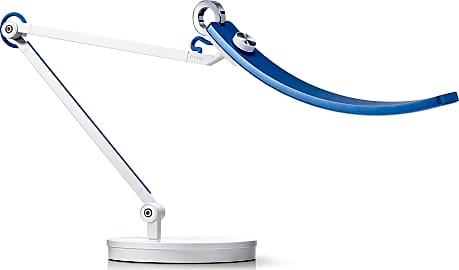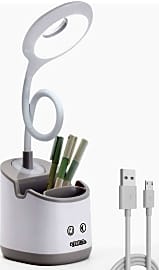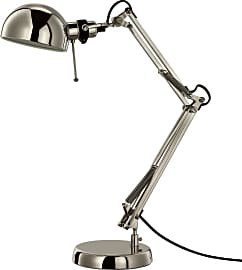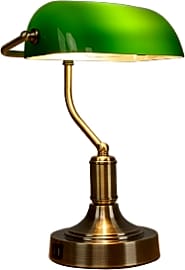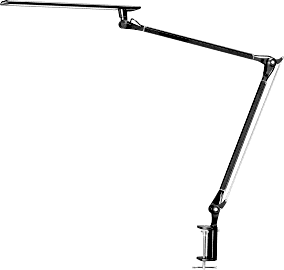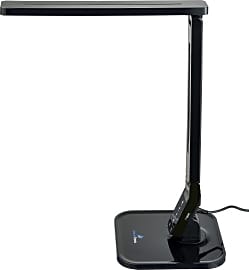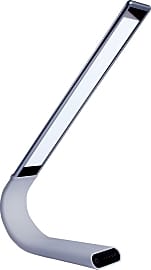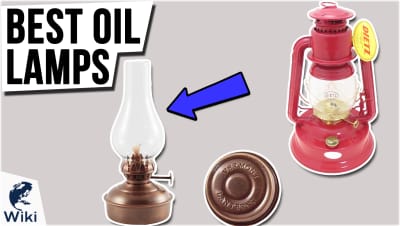The 10 Best Desk Lamps

This wiki has been updated 40 times since it was first published in June of 2015. Good lighting is crucial to getting work done, and the right selection will brighten a workspace while reducing eye strain as well as electricity bills. Ranked by cost, aesthetics, and function, these desk lamps will illuminate any task, from drafting and design to studying for exams — and many look pretty good while doing it, too, whether you prefer traditional or modern decor. When users buy our independently chosen editorial selections, we may earn commissions to help fund the Wiki.
Editor's Notes
April 29, 2021:
In this update, we replaced the Catalina Traditional Bankers with the Mlambert Banker's, which offers a similar aesthetic, with a sturdy metal base and a green glass shade, but has a few touches that make it a better fit for a modern office: two USB charging ports and a dimmer function with three different settings.
We replaced the Victory Gooseneck with the Decorus Student in order to bring an option with a built-in desk organizer to the list. This one is a good choice for a dorm room, since it has a small footprint, a phone stand, and a USB-rechargeable battery, making it easy to bring to a student center or library if needed. For younger kids, it can keep school supplies in order and double as a nightlight.
The OttLite Slimline was replaced with the Yostyle Eye-Caring. It has a similar shape to the OttLite and can fold down for easy storage or to create more workspace. But the Yostyle also offers several charging ports (4 USB and 2 AC) so you can keep all of your devices powered up while you work. It also has a generous 8.2-foot power cable, so you won't need to bother with an extension cord.
The Brightech Zoey was removed due to availability concerns. In its place, we added the Torchstar Multi-Joint. The lamp's classic and practical shape, with several points that can be adjusted, should appeal to adults, but since it's reminiscent of the lamp used in the Pixar logo, it's not a bad choice for kids either. It comes in three colors and has two interchangeable bases. However, note that this one doesn't come with a lightbulb, and that a standard bulb may stick out from the shade.
March 13, 2020:
When it comes to efficient lighting for a relatively pain-free price, we still think the popular TaoTronics LED is tough to top. With five color modes and seven brightness levels, it can accommodate a wide range of users; not only that, but it offers plenty of adjustability with its rotating head, so you won't struggle to achieve a comfortable position. The (somewhat expensive) BenQ e-Reading is also quite useful, although it can be frustrating to operate. The color temperature knob and control ring are close together, so it's easy to inadvertently touch one while attempting to access the other. The pros largely outweigh this small con, however, especially for those who demand flicker-free, even illumination. And speaking of even illumination, we've opted to add the OttLite Slimline. OttLites have long been a favorite of the crafting crowd for their comfortable, glare-free lighting that shows colors accurately, so if you have any creative work to perform at your desk, it's a good choice.
We've also decided to add a smartphone charging lamp at this time, the Brightech Zoey. Its wireless charging function is compatible with many newer devices, but it has a USB port that allows you to charge smartphones or tablets that cannot be charged wirelessly. But for those on the opposite end of the tech spectrum, who want a traditional lamp without tons of extras, we selected the Catalina Traditional Bankers, which comes in several colors, including the classic brass with green shade.
Special Honors
Dyson Lightcycle You can adjust the Dyson Lightcycle with your smartphone, or you can let the daytime algorithm do the work, since the lamp utilizes your phone's GPS data and more to provide optimal illumination throughout the day. There are several modes to select from, including one for studying and one for relaxing, or you can create personal pre-sets that are tailored to your needs. dyson.com
Fully Beam The Fully Beam, unlike many, is offered in your choice of a clamp or pedestal base, so it's easily usable with just about any desk you can think of. But no matter which you choose, you can expect a sturdy steel and aluminum construction, touch-sensitive controls, four light temperature settings, and more. fully.com
Herman Miller Ode The Herman Miller Ode is quite pricey for what is a fairly simple model, but the incredibly stylish modern design and the cachet carried by the name more than make up for it for many users. Standing nearly 18 inches tall, it's an amply sized choice, and it boasts a long 12-foot power cord for your convenience. store.hermanmiller.com
Choosing The Right Desk Lamp
Many sleek and compact desk lamps require minimal desk space yet provide bright illumination, often thanks to LED bulbs.
Eyes are like other muscles in your body; they get tired and need a break. This is especially true when they work harder than usual in poor lighting conditions.
While unlikely to cause permanent damage -- despite a parent's admonition to a child trying to peruse a comic book at night by smuggled flashlight -- trying to read or type in low light can cause acute eyestrain. This can present symptoms including headache, fatigue, and sore, tired eyes. The remedy for eyestrain is rather simple: just rest your eyes (and the rest of yourself) and try to avoid the conditions that caused the discomfort in the first place.
Adding a desk lamp to your work area is the best way to avoid the eyestrain associated with non screen reading (or the viewing of graphics, charts, etc.). A desk lamp allows you to direct light exactly where you need it without changing the overall illumination of an interior. Thus desk lamps allow you to add illumination to your own work space without impacting others. If you have a private office all to yourself, this will matter less; if you share a bay of desks or work in a cubicle, then a desk lamp may be the only practical way to add light to your space.
When choosing a lamp for work, you will want to focus on function more than form. Many sleek and compact desk lamps require minimal desk space yet provide bright illumination, often thanks to LED bulbs. Make sure you factor in the range of brightness settings a lamp offers; you will likely want to dim and brighten your desk lamp at times. When choosing a desk lamp for the home, you have more latitude in terms of size, appearance, and brightness. Consider where it will sit in your home and pick a lamp that will look great there, off or on.
Also consider the color temperature of a desk lamp. Many are bright enough to help with reading, but give off light that is a pale white hue that can be unpleasant. Others shine with a "yellow" light that may be more appealing; some options offer both color temperatures.
Making The Most Of Your Desk Lamp
A desk lamp can serve more as a decorative than a functional piece; if you are choosing a lamp for its looks more than its light, you are free to let you inner interior designer run wild. One look at the many stunning lamps offered by a venerable maker such as Tiffany, for example, will justify the choice of a lamp as ornament more than light fixture.
If you have chosen a lamp with a gooseneck design, then it can be easy to move the light source closer to and farther from the pages or pictures before you.
However the primary purpose of a lamp is illumination. Thus once you have chosen a desk lamp with a lumen output that suits your needs and with aesthetics you appreciate, it's important you place the lamp properly. If you have chosen a lamp with a gooseneck design, then it can be easy to move the light source closer to and farther from the pages or pictures before you. These types of lamps are also easier to move entirely out of your field of view without moving their base.
Many modern desk lamps are so lightweight and compact that they can be moved about your desk or even brought to other areas of your home or office; don't be afraid to move a desk lamp around frequently. Too often people treat a piece of furniture or a fixture as immovable once it has been set in a given place. Such is hardly the case: you should reposition your lamp as often as you need for ease of reading to to accommodate the other items sharing the desk.
A Brief But Illuminating History Of Lamps
The word "lamp" was first used to describe the oil lamp, a primitive but effective tool that could produce light and a bit of heat for hours on end when properly maintained. More stable than a torch and producing a more lasting flame than a candle, oil lamps were used all around the ancient world, from the Arctic to Africa to Greece and Rome to the Far East and Near East.
They provided a cheap, reliable, and safe form of light that controlled with the flick of a switch.
In the late 18th Century, gas lighting first came to prominence. Natural gas produced a relatively cleanly burning light and was available in abundance. Gas lighting would be the primary source of illumination throughout much of the 19th Century, with streets and homes alike featuring gas lamps. Just as quickly as this new technology had supplanted the age old candle and oil lamp, it too would see its position usurped by electric light.
First developed by Humphry Davy in the first decade of the 1800s but not made practical until the work of Thomas Edison decades later, the incandescent lightbulb would be the primary light source of the 20th Century. Available in all shapes and sizes, capable of lighting up whole city blocks or of twinkling softly among the boughs of a Christmas tree, incandescent lightbulbs represented a monumental leap forward in illumination technology. They provided a cheap, reliable, and safe form of light that controlled with the flick of a switch.
While today LED, halogen, and other types of lightbulb are growing popular, they are designed to fit into sockets created for incandescent bulbs. Chances are good that your own home and office are both loaded with incandescent lights largely taken for granted save when they fail. We rely on illumination so casually we scarcely think about it until that moment a bulb burns out, or until we realize we are straining to see the pages of a book or the keys of out computer. Often, then, a hand stretches out and flips a switch or pulls a cord, bringing to life a humble yet indispensable object known as the desk lamp.


